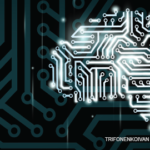 As I was aimlessly browsing the web one night, I noticed a strange ad on the side. It was for a bird feeder powered by artificial intelligence (AI). I don’t know exactly what prompted the Google ad algorithm to show me this particular advertisement, but I was nevertheless struck by it. Against my better judgment, I clicked on it, knowing without a doubt that for the next few weeks, I’ll see nothing but ads about bird feeders whenever I open a web browser.
As I was aimlessly browsing the web one night, I noticed a strange ad on the side. It was for a bird feeder powered by artificial intelligence (AI). I don’t know exactly what prompted the Google ad algorithm to show me this particular advertisement, but I was nevertheless struck by it. Against my better judgment, I clicked on it, knowing without a doubt that for the next few weeks, I’ll see nothing but ads about bird feeders whenever I open a web browser.
After looking through the product specifications, I gained some insight into what the future of rheumatology may look like in a world where even bird feeders are artificially intelligent. So what are the barriers and challenges to artificially intelligent rheumatology clinics? Let’s rheuminate!
Springtime for AI, or Impending Winter?
AI appears to be a modern invention, but the fact is that AI is over 70 years old. Alan Turing, a computer scientist who helped the Allies win World War II, is credited with being the father of AI, although the term itself did not come into use until 1956.1 Since then, AI has moved ahead in a series of fits and starts.
Throughout much of the 1970s and 1980s, AI seemed to experience a series of AI winters, periods marked by significant declines in enthusiasm and funding.2 These downturns followed inflated expectations that outpaced the technology’s capabilities, leading to widespread disillusionment.
History is ever cyclical, but you can imagine my concern that this enthusiasm for AI bird feeders and AI toasters may be presaging another AI winter. The proponents, though, have a great point: Advances in computing power, exploration of advanced algorithms and scalability make it so much easier to sustain artificial intelligence today.
This historical context is crucial because it frames a realistic perspective on discussing AI’s role in rheumatology. AI certainly has the potential to revolutionize rheumatology, but so far, it is only that: potential. Computers are not going to do the heavy lifting to implement themselves into our clinics. It is we, flesh-and-bone humans, who have to create achievable goals based on grounded expectations to ensure AI can be sustained in clinics, labs and beyond.
Demystifying AI
A major reason AI-powered bird feeders even exist is because of the mystique of AI. It’s hard not to argue that it is magic when a machine completes a task that you’ve been working on for hours in a matter of seconds. But it is decidedly not magic.
AI operates via meticulously crafted algorithms—essentially a series of if-then-else decisions executed at incredibly high speeds. These algorithms allow machines to learn from data and make predictions or decisions, mimicking human-like cognition, but lacking true consciousness.3
Perhaps because AI looks so human but is not human, we view it with great reverence. Yet this reverence is not deserved. We humans need to demystify AI so we can set realistic expectations for its capabilities and limitations, ensuring that AI is viewed as a tool rather than a solution in itself.
The reverse is true too. Rodney Brooks, a prominent researcher and computer scientist once quipped, “Every time we figure out a piece of it, it stops being magical; we say, ‘Oh, that’s just a computation.’” This sentiment is vital in rheumatology, where we generate diagnoses as if by magic. We can use artificial intelligence to approximate that diagnostic process, but it’s not the same sort of magic that comes with an aha moment. It’s precise calculation, which no doubt enhances patient care but cannot, at least at this point in time, replace the nuanced judgment, empathic connection and personalized care provided by a skilled rheumatologist.
Applications & Limitations
AI’s foray into rheumatology and medicine at large has been cautious yet promising. Current applications, such as AI-powered dictation tools and automated letters for prior authorization, aim to streamline administrative burdens, allowing rheumatologists more time to focus on patient care. However, the use of AI in direct diagnostic processes and treatment planning is still in its infancy, challenged by such issues as data quality, algorithmic bias and the complex nature of autoimmune rheumatic diseases.
Moreover, with AI, we are asking computers to solve problems that humans have made. No cosmic law stipulates physicians and other healthcare team members must spend as much time documenting outside clinic as we do spending time with patients.4 We humans have placed these regulations on ourselves. Only we humans can undo these harmful acts through dedicated advocacy and collective action. The computers can make us feel somewhat better, but all that AI is doing is streamlining an incredibly broken and bloated healthcare system.
The closest historical analog I can think of is the introduction of the electronic medical record. It was supposed to be a panacea, but a good 20 years after implementation, we find it only reinforced the worst habits of our healthcare system and disempowered patients and clinicians at the expense of large organizations and their administrators. Just like then, we see two competing visions of the future: one that is boundless with possibility due to machines extending our capacity to do good, while the other binds us to machines so that we can enhance our productivity for others.
Machines cannot help us make this choice; it is up to us.
Integrating AI Holistically
This brings us to our next point: For AI to be truly effective in rheumatology clinics, AI-powered tools must be integrated in a manner that respects and enhances the entire diagnostic and care continuum. Holistic integration means designing AI tools that complement the clinician’s workflow, enhancing our ability to deliver patient-centered care without fragmenting or complicating the treatment process. This is easier said than done.
The diagnostic process is more than what happens in a clinic room between a clinician and a patient. The National Academies of Sciences, Engineering, and Medicine, in conjunction with the Society to Improve Diagnosis in Medicine, published a schema outlining the diagnostic process, which starts when a patient experiences a health concern and ends, broadly, with outcomes for the patient and for the system.5 It’s vital that AI not just be wedged into one small element of this diagnostic process, but be integrated seamlessly through the entire process.
Once more, the experience of the electronic health record system is edifying. Once relegated to writing and reading notes, the EHR has now grown to become a sprawling platform that encompasses virtually all elements of patient care, often at the expense of human-centered care. I contend that, unless carefully designed, artificial intelligence will do much the same.
Looking for Human-Centered AI
It goes without saying that AI solutions in rheumatology should not adopt a one-size-fits-all approach. Instead, they must be tailored to fit the specific needs of each clinical setting. This customization requires active input from clinicians, patients and many others who understand the unique challenges and needs of their practice environments. By aligning AI tools with these specific requirements, we can ensure AI can be a useful adjunct to enhance clinical practice.
The issue of culture must be addressed here. Large language models (LLMs) are a major component of modern AI tools. But they carry with them, and reinforce, enormous, unmistakable biases.6 The language that AI tools embrace is the language of standardization and, broadly, of the elite. The richness of regional lexicons and the precision they carry are often lost in the data to create LLMs that are marketable beyond individual counties, states and countries. Worse yet, many of the biases intrinsic in language are left uncontested, perpetuating harm.
Even if they were somehow able to faithfully replicate our way of speaking and writing, AI tools in healthcare would be fundamentally misleading and manipulative.
As of 2024, computers do not have the ability to empathize.7 Rather, they can create words that can provoke certain sensations and sentiments among humans. When an AI chatbot tells us how important it is to take allopurinol because it cares about a patient, we should be rightfully suspicious. Humans have the ability to develop social relationships with inanimate objects, and AI has been shown to have the capacity to be manipulative and deceptive.8 Without safeguards from humans, we are inviting AI to provide sociopathic care.
Implications of AI
Beyond ethical considerations, integrating AI into healthcare is not without its economic and environmental implications. AI does not exist isolated in a box, but is rather entwined with the natural world.
Running tools powered by AI is not without costs. Although the numbers are difficult to find, one report suggests that operating ChatGPT costs approximately $700,000 per day. Electricity, water (for cooling), rental costs and more are all part of these operating expenses. Currently, these costs are somewhat subsidized by investors who anticipate their AI products will become more profitable as they become ubiquitous, but there is no guarantee this will continue. In a healthcare system that already has exorbitant costs with unclear benefits, are we ready to become one of these investors?
This cost does not even address the environmental aspects of AI. Computers and computer systems are reliant upon rare earth metals. Mining these is extremely detrimental to the environment. Additionally, to power them, electricity must be derived from sources that may not necessarily be eco-friendly. And lastly, servers need to be cooled by water, an increasingly scarce resource. Worldwide, it may require 6.6 billion m3 of water by 2027 to operate AI servers. Strategies to mitigate these negative consequences are in dire need before we implement AI within an industry that comprises 18% of our national gross domestic product.
Thoughtful De-implementation
While we rush toward the idea of implementing something new, we always have to keep our eyes on de-implementing what is old. This de-implementation must be managed carefully to ensure we don’t contribute to bloat and system redundancy. With AI updates coming at an increasingly rapid rate, healthcare leaders must prioritize plans for de-implementation of obsolete models and technologies.
De-implementation is not easy, but it is essential for diversity, equity and inclusion considerations. Innovations rarely spread in an equitable manner, but rather diffuse within communities and societies. Not surprisingly, when a resource-intensive innovation, like AI, comes to the fore the communities that do not have free resources will be the last to obtain its benefits. This is why de-implementation is important: It places the onus of healthcare equity back on those who are most eager to implement, so they can think clearly and holistically about how their additions will necessarily lead to subtraction of care from others.
Shaping Our Own Future
As AI continues to evolve, it is imperative that rheumatologists play an active role in shaping AI’s integration into the field. We can neither be swept up by the overenthusiastic promises of AI marketeers nor ignore the very real and tangible good that technological advances can provide our patients. We must be careful and deliberative with our adoption of technologies, such as AI, in an age that values the next shiny penny. Only by engaging in advocacy and dialogue with policymakers and technocrats can we ensure the development of AI technologies align with the foundational values we cherish in the field of rheumatology, particularly the emphasis on patient-centered care.
Rheumatologists must also stay informed about the advancements in AI to use these technologies effectively in our practice. It’s not an exaggeration to say that we need to embrace computer science and programming as a competency in our fellowship programs and offer continuing medical education programs in informatics. This proactive approach will ensure that AI is used as a tool to enhance, and not commodify, the nuanced art of rheumatology.
In short, AI is advancing at a rapid pace, but it can never catch up to genuine human wisdom. In the ideal world, we will harmonize artificial intelligence with genuine human wisdom, and, in the process, advance the art and the science of rheumatology. Until that happens, I’ll keep getting ads for artificially intelligent bird feeders.
 Bharat Kumar, MD, MME, FACP, FAAAAI, RhMSUS, is the director of the rheumatology fellowship training program at the University of Iowa, Iowa City, and the physician editor of The Rheumatologist. Follow him on X (formerly Twitter) @BharatKumarMD.
Bharat Kumar, MD, MME, FACP, FAAAAI, RhMSUS, is the director of the rheumatology fellowship training program at the University of Iowa, Iowa City, and the physician editor of The Rheumatologist. Follow him on X (formerly Twitter) @BharatKumarMD.
References
- Mintz Y, Brodie R. Introduction to artificial intelligence in medicine. Minim Invasive Ther Allied Technol. 2019 Apr;28(2):73–81.
- Toosi A, Bottino AG, Saboury B, et al. A brief history of AI: How to prevent another winter (A critical review). PET Clin. 2021 Oct;16(4):449–469.
- De Togni G, Erikainen S, Chan S, et al. Beyond the hype: ‘Acceptable futures’ for AI and robotic technologies in healthcare. AI Soc. 2023 Apr:1–10.
- Ammenwerth E, Spötl HP. The time needed for clinical documentation versus direct patient care. A work-sampling analysis of physicians’ activities. Methods Inf Med. 2009;48(1):84–91.
- Committee on Diagnostic Error in Health C, Board on Health Care S, Institute of M, The National Academies of Sciences E, Medicine. Balogh EP, Miller BT, Ball JR, eds. Improving diagnosis in health care. Washington (DC): National Academies Press. 2015.
- Wornow M, Xu Y, Thapa R, et al. The shaky foundations of large language models and foundation models for electronic health records. NPJ Digit Med. 2023 Jul;6(1):135.
- Perry A. AI will never convey the essence of human empathy. Nat Hum Behav. 2023 Nov;7(11):1808–1809.
- Park PS, Goldstein S, O’Gara A, et al. AI deception: A survey of examples, risks, and potential solutions. Patterns (N Y). 2024 May;5(5):100988.



